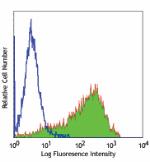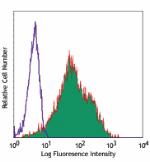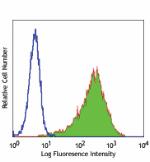- Clone
- 18A2 (See other available formats)
- Regulatory Status
- RUO
- Other Names
- Platelet-derived growth factor receptor, beta polypeptide, PDGFR1, PDGFRβ, PDGFRb, PDGF receptor beta
- Isotype
- Mouse IgG1, κ
- Barcode Sequence
- CAATGGTTCACTGCC
| Cat # | Size | Price | Quantity Check Availability | ||
|---|---|---|---|---|---|
| 323615 | 10 µg | $369.00 | |||
CD140b is a cell surface tyrosine kinase receptor for members of the platelet-derived growth factor family. The identity of the growth factor bound to the receptor determines whether the functional receptor is a homodimer or heterodimer composed of both PDGFR-α and -β. CD140b contains two immunoglobulin-like domains and a tyrosine kinase domain with a predicted molecular weight approximately 124 kD. CD140b is widely expressed on a variety of mesenchymal-derived cells and is preferentially expressed on some tumors such as medulloblastoma. Binding of B-chain containing PDGF molecules can stimulate cell proliferation. CD140b has been shown to interact with a number of kinases (including Raf-1, NCK1, FAK, Fyn, others) as well as adaptor molecules and signaling intermediates (Crk, Grb2, Grb4, RasGAP, SHP2, SHC1, others), and has also been shown to associate with integrin β3 and nexin sorting molecules. CD140b has been implicated in several disease states including atherogenesis and oncogenesis. The PDGFRβ is heavily phosphorylated on numerous tyrosine residues through both autophosphorylation and ligand-dependent processes.
Product Details
- Verified Reactivity
- Human
- Reported Reactivity
- African Green, Baboon, Cynomolgus, Rhesus
- Antibody Type
- Monoclonal
- Host Species
- Mouse
- Immunogen
- NIH-3T3 cells transfected with human PDGFRbeta
- Formulation
- Phosphate-buffered solution, pH 7.2, containing 0.09% sodium azide and EDTA
- Preparation
- The antibody was purified by chromatography and conjugated with TotalSeq™-B oligomer under optimal conditions.
- Concentration
- 0.5 mg/mL
- Storage & Handling
- The antibody solution should be stored undiluted between 2°C and 8°C. Do not freeze.
- Application
-
PG - Quality tested
- Recommended Usage
-
Each lot of this antibody is quality control tested by immunofluorescent staining with flow cytometric analysis and the oligomer sequence is confirmed by sequencing. TotalSeq™-B antibodies are compatible with 10x Genomics Single Cell Gene Expression Solutions.
To maximize performance, it is strongly recommended that the reagent be titrated for each application, and that you centrifuge the antibody dilution before adding to the cells at 14,000xg at 2 - 8°C for 10 minutes. Carefully pipette out the liquid avoiding the bottom of the tube and add to the cell suspension. For Proteogenomics analysis, the suggested starting amount of this reagent for titration is ≤ 1.0 µg per million cells in 100 µL volume. Refer to the corresponding TotalSeq™ protocol for specific staining instructions.
Buyer is solely responsible for determining whether Buyer has all intellectual property rights that are necessary for Buyer's intended uses of the BioLegend TotalSeq™ products. For example, for any technology platform Buyer uses with TotalSeq™, it is Buyer's sole responsibility to determine whether it has all necessary third party intellectual property rights to use that platform and TotalSeq™ with that platform. - Application Notes
-
The 18A2 monclonal antibody recognizes human CD140b also known as the platelet-derived growth factor receptor, beta polypeptide, PDGFR1, and PDGFRß. It has been shown to be useful for flow cytometric detection of CD140b.
- Additional Product Notes
-
TotalSeq™ reagents are designed to profile protein levels at a single cell level following an optimized protocol similar to the CITE-seq workflow. A compatible single cell device (e.g. 10x Genomics Chromium System and Reagents) and sequencer (e.g. Illumina analyzers) are required. Please contact technical support for more information, or visit biolegend.com/totalseq.
The barcode flanking sequences are GTGACTGGAGTTCAGACGTGTGCTCTTCCGATCTNNNNNNNNNN (PCR handle), and NNNNNNNNNGCTTTAAGGCCGGTCCTAGC*A*A (capture sequence). N represents either randomly selected A, C, G, or T, and * indicates a phosphorothioated bond, to prevent nuclease degradation.
View more applications data for this product in our Scientific Poster Library. -
Application References
(PubMed link indicates BioLegend citation) -
- Vogel W, et al. 2002. Haematologica 88:126.
- Arima, S., et al 2011. Development. 138:4763. PubMed.
- RRID
-
AB_3097598 (BioLegend Cat. No. 323615)
Antigen Details
- Structure
- Cell surface tyrosine kinase receptor for members of the platelet-derived growth factor family. The identity of the growth factor bound to the receptor determines whether the functional receptor is a homodimer or heterodimer composed of both PDGFR1 and PD
- Distribution
-
Widely expressed on a variety of mesenchymal-derived cells. Preferentially expressed in medulloblastoma.
- Function
- Stimulation of cell proliferation; mitogenic activity for cells of mesenchymal origin. Has been implicated in atherogenesis and oncogenesis.
- Interaction
- Interacts with a number of kinases (including Raf-1, NCK1, FAK, Fyn, others) as well as adaptor molecules and signaling intermediates (Grb2, Grb4, RasGAP, SHP2, SHC1, Crk, others). Has also been shown to associate with integrin β3 and nexin sorting m
- Ligand/Receptor
- Binds to B-chain containing PDGF molecules as well as protease-activated PDGF-C
- Modification
- Multiple tyrosine phosphorylation sites (Y549, Y581, Y716, Y740, Y751, Y763, Y771, Y775, Y857, Y1009, Y1021)
- Cell Type
- Embryonic Stem Cells, Mesenchymal cells, Mesenchymal Stem Cells
- Biology Area
- Angiogenesis, Cell Biology, Immunology, Neuroscience, Neuroscience Cell Markers, Stem Cells
- Molecular Family
- CD Molecules, Cytokine/Chemokine Receptors
- Antigen References
-
1. Claesson-Welsh L, et al. 1988. Mol. Cell Biol. 8:3476.
2. Gronwald RG, et al. 1988. Proc. Natl. Acad. Sci. USA 85:3435.
3. Gilbertson DG, et al. 2001. J. Biol. Chem.276:27406.
4. Seifert RA, et al. 1989. J. Biol. Chem. 264:8771.
5. Kanakaraj P, et al. 1991. Biochemistry 30:1761. - Gene ID
- 5159 View all products for this Gene ID
- UniProt
- View information about CD140b on UniProt.org
Other Formats
View All CD140b Reagents Request Custom Conjugation| Description | Clone | Applications |
|---|---|---|
| Purified anti-human CD140b (PDGFRβ) | 18A2 | FC |
| Biotin anti-human CD140b (PDGFRβ) | 18A2 | FC |
| PE anti-human CD140b (PDGFRβ) | 18A2 | FC |
| APC anti-human CD140b (PDGFRβ) | 18A2 | FC |
| TotalSeq™-A0129 anti-human CD140b (PDGFRβ) | 18A2 | PG |
| TotalSeq™-C0129 anti-human CD140b (PDGFRβ) | 18A2 | PG |
| TotalSeq™-D0129 anti-human CD140b (PDGFRβ) | 18A2 | PG |
| TotalSeq™-B0129 anti-human CD140b (PDGFRβ) | 18A2 | PG |
Compare Data Across All Formats
This data display is provided for general comparisons between formats.
Your actual data may vary due to variations in samples, target cells, instruments and their settings, staining conditions, and other factors.
If you need assistance with selecting the best format contact our expert technical support team.
-
Purified anti-human CD140b (PDGFRβ)

Human PDGFRB transfected cells stained with purified 18A2, f... -
Biotin anti-human CD140b (PDGFRβ)

Human PDGFRB transfected cells stained with biotinylated 18A... -
PE anti-human CD140b (PDGFRβ)

Human PDGFRB transfected cells stained with purified 18A2 PE -
APC anti-human CD140b (PDGFRβ)

Human PDGFRB transfected cells stained with 18A2 APC -
TotalSeq™-A0129 anti-human CD140b (PDGFRβ)
-
TotalSeq™-C0129 anti-human CD140b (PDGFRβ)
-
TotalSeq™-D0129 anti-human CD140b (PDGFRβ)
-
TotalSeq™-B0129 anti-human CD140b (PDGFRβ)
